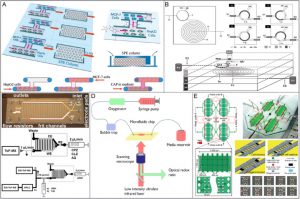Abstract
The development of pharmaceutical analytical methods represents one of the most significant aspects of drug development. Recent advances in microfabrication and microfluidics could provide new approaches for drug analysis, including drug screening, active testing and the study of metabolism. Microfluidic chip technologies, such as lab-on-a-chip technology, three-dimensional (3D) cell culture, organs-on-chip and droplet techniques, have all been developed rapidly. Microfluidic chips coupled with various kinds of detection techniques are suitable for the high-throughput screening, detection and mechanistic study of drugs. This review highlights the latest (2010–2018) microfluidic technology for drug analysis and discusses the potential future development in this field.
1. Introduction
Microfluidic technology has been developed rapidly in recent decades and offers multitudinous application in life sciences. The microfluidics revolution arose due to the distinct advantages offered by system miniaturization, including the high analytical throughput, enhanced sensitivity, improved analytical performance, facile parallelization through multiplexing, the ability to handle and process reduced reagent volumes and vastly reduced instrumental footprints.
Drug development involves several main processes, such as drug discovery, preclinical tests, and clinical trials, to develop a new drug for the market. Pharmaceutical analysis is prevalently utilized in all of these processes. However, this complicated process still faces some challenges from significant issues such as time consumption, low-throughput and cost. Microfluidics, as a miniaturization technology, could simultaneously provide analytical efficiency and high-throughput capabilities, without the loss of precision and automation. During the process of drug application, microfluidics technology is not only a powerful instrument for the rapid screening and analysis of drug discovery but also lower costs and reagent consumption by its miniaturized devices. The volume of the microfluidic chip device is minimal and many functions can be integrated on a chip of several centimeters. The internal dimensions of the chip range from micrometers to millimeters, so the consumption of the samples and reagents is at the nanoliter and picoliter levels [1], [2]. Multichannel and array designs allow high-throughput to be achieved, which can increase the screening speed by hundreds of times and can decrease costs [3].
Since the pioneering development in the early 1990s, microfluidic technology has been applied in a variety of research fields including chemical synthesis [4], proteomics [5], single cell analysis [6], tissue engineering, high-throughput screening, environmental analysis and medical diagnostics. Such platforms provide new insights into biological processes and enable the efficient and rapid generation of novel pharmaceutical analysis. Microfluidic technology is being used to develop cost-effective in vitro models for lead compounds that can more reliably predict the efficacy, toxicity and pharmacokinetics of drug compounds in humans, as well as for novel screening assays. Microfluidic devices are recognized as advantageous not only for saving space and scarce/expensive materials but also because miniaturization offers several additional superiorities. This technology has become an increasingly promising tool for basic and applied research on drugs.
We introduce the application of microfluidic chips in drug analysis, including drug screening, drug determination, drug metabolism, toxicity, evaluation and other aspects. The innovations of these chips connected new research methods with drug analysis. Micro-droplets, 3D cell culture, organ microchips and other application are introduced coupled with recent literatures. This review provides a new insight into the research of drug analysis. Table 1 describes the significant use of microfluidic chips in this area and summarizes the device features and related representative literature.

